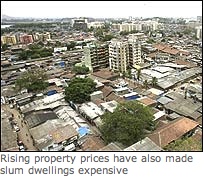lessons to learn, mumbai redux:
new housing policy
 BBC reports that Mumbai is enacting a new housing policy to "...make housing available and affordable for all, especially the lower and middle-income groups."
BBC reports that Mumbai is enacting a new housing policy to "...make housing available and affordable for all, especially the lower and middle-income groups."
The city is already one of the most expensive places to live in India -but the population of the megalopolis, 16.M in 2000 (fifth largest in the world), is slated to climb t0 22.6M by 2015 (by then, second only to Tokyo and outstripping Delhi and Mexico City).* That's a growth rate of over 430,000 each year!
Metro Manila's growth rate is somewhere near 185,000/year (good enough to pull us to 16th largest metropolis by 2015), but our housing shortfall is just as bad. As of last year, the housing shortfall for NCR alone was over 1M (HUDCC figures).
From the BBC article:Chairman of Knight Frank property consultants in India, Pranay Vakil, says the reason for such astronomical rates is because the supply is limited.
Note one of the reasons why Mumbai got into this trouble:
"The requirement for Mumbai is 84,000 houses a year, while the government and private players combined can offer only 55,000.
"So with a shortfall as big as that, is it any surprise that the prices have sky-rocketed and informal housing has grown beyond control?" he asks.
Informal housing is estate agents' parlance for slums, in which more than 60% of the city's 18 million people live.Lack of organised renting and archaic rental laws further compound the problem and have pushed up property prices.
The policy intends to:
"There is not a single company or developer constructing only rental apartments and buildings like the kind you find in Europe and the United States," he said.
A 1947 law regulating tenancy and rent is another problem.
It has frozen rents at the 1947 levels, and protects tenants against eviction. (Note: Sounds familiar?)
This has delayed the freeing up of a large number of flats that continue to be occupied by people who pay unrealistically low rents....(promote) rental housing and new construction, redevelopment of slums and old buildings and boosting foreign investment in the housing sector.
I have my own thoughts on how we can harness market forces to cover our own shortfall (leveraging infra investments by location efficient property taxes, location efficient mortgages, inclusionary zoning, etc. -will write about these soon) but for now we can study Mumbai's new policy -to see if it would be a model we can adapt.
The policy also promotes special township schemes just outside the municipal limits of Mumbai so that people working in the city can find homes to suit their budgets.
Image credit: BBC News.

No comments:
Post a Comment